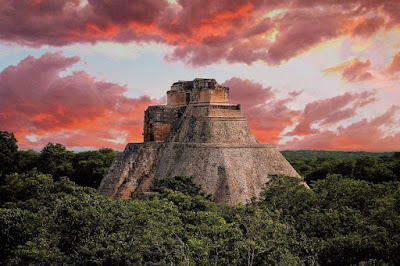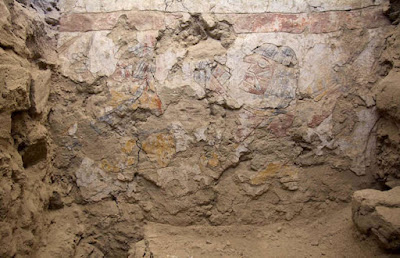Archeologists map lost cities in Ecuadorian Amazon, settlements that lasted 1,000 yearsWASHINGTON, DC [outside of USA, in "
Columbia," and reigning over it] — Archeologists have uncovered a cluster of lost cities in the Amazon rainforest that was home to at least 10,000 farmers around 2,000 years ago.
A series of
earthen mounds [like Buddhist
stupas, tepes (
tels)
, kurgans, and barrows (
tumulus)] buried roads in Ecuador was first noticed more than two decades ago by archaeologist Stéphen Rostain.
 |
| Map of Ecuador with Amazon (wiki) |
But at the time, " I wasn’t sure how it all fit together,” said Rostain, one of the researchers who reported on the finding Thursday [1/11/24] in
the journal Science.
Recent mapping by laser-sensor technology [
LiDAR] revealed those sites to be part of a dense network of settlements and connecting roadways, tucked into the forested foothills of the Andes [most of which are in Peru], that lasted about 1,000 years.
 |
| Meso-, S. America were advanced places on earth |
“It was
a lost valley of cities," said Rostain, who directs investigations at France’s National Center for Scientific Research. “It's incredible.”
The settlements were occupied by the
Upano people between around 500 B.C. and 300 to 600 A.D. — a period roughly contemporaneous with the
Roman Empire in Europe, the researchers found.
Residential and ceremonial buildings erected on more than 6,000 earthen mounds were surrounded by agricultural fields with drainage canals. The largest roads were 33 feet (10 meters) wide and stretched for 6 to 12 miles (10 to 20 kilometers).
 |
| LiDAR scans reveal topographical features like X-rays reveal bones: This LiDAR image provided by researchers in Jan. 2024 shows a main street crossing an urban area, creating an axis along which complexes of rectangular platforms are arranged around low squares at the Copueno site, Upano Valley in Ecuador. Archeologists have uncovered a cluster of lost cities in the Amazon rainforest that was home to at least 10,000 farmers around 2,000 years ago, according to a paper published Thursday, Jan. 11, 2024, in the journal Science (Antoine Dorison, Stéphen Rostain via AP/MSN). |
.
While it’s difficult to estimate populations, the site was home to at least 10,000 inhabitants — and perhaps as many as 15,000 or 30,000 at its peak, said archaeologist Antoine Dorison, a study co-author at the same French institute. That's comparable to the estimated population of Roman-era London, then Britain’s largest city.
“This shows a very dense occupation and an extremely complicated society,” said University of Florida archeologist Michael Heckenberger, who was not involved in the study. “For the region, it’s really in a class of its own in terms of how early it is.”
 |
| Recent discovery in Peru, where new art was found, Moche, Inca (Lisa Trever via MSN) |
 |
| The Amazon jungle is alive and conscious |
José Iriarte, a University of Exeter archaeologist, said it would have required an elaborate system of organized labor to build the roads and thousands of earthen mounds.
“The Incas and Mayans built with stone, but people in Amazonia didn’t usually have stone available to build — they built with mud. It’s still an immense amount of labor,” said Iriarte, who had no role in the research.
 |
| Neighboring Guatemala, just below Mexico, has Tikal, Mayan ruins in the jungle (2009) |
.
 |
| The star people helped us build these marvels. |
The Amazon is often thought of as a "pristine wilderness with only small groups of people. But recent discoveries have shown us how much more complex the past really is,” he said.
Scientists have recently also found evidence of intricate rainforest societies that
predated European contact elsewhere in the Amazon,
including in Bolivia and
in Brazil.
“There’s always been an incredible diversity of people and settlements in the Amazon, not only one way to live,” said Rostain. “We’re just learning more about them.”
 |
| There was more to the Inca of Peru besides the amazing Machu Picchu (Reuters via jpost.com) |
___
The Associated Press Health and Science Department receives support from the Howard Hughes Medical Institute’s Science and Educational Media Group [and therefore may be biased and willing to cave in to corporate pressure for all of its reporting.].









































































































































































































































































No comments:
Post a Comment